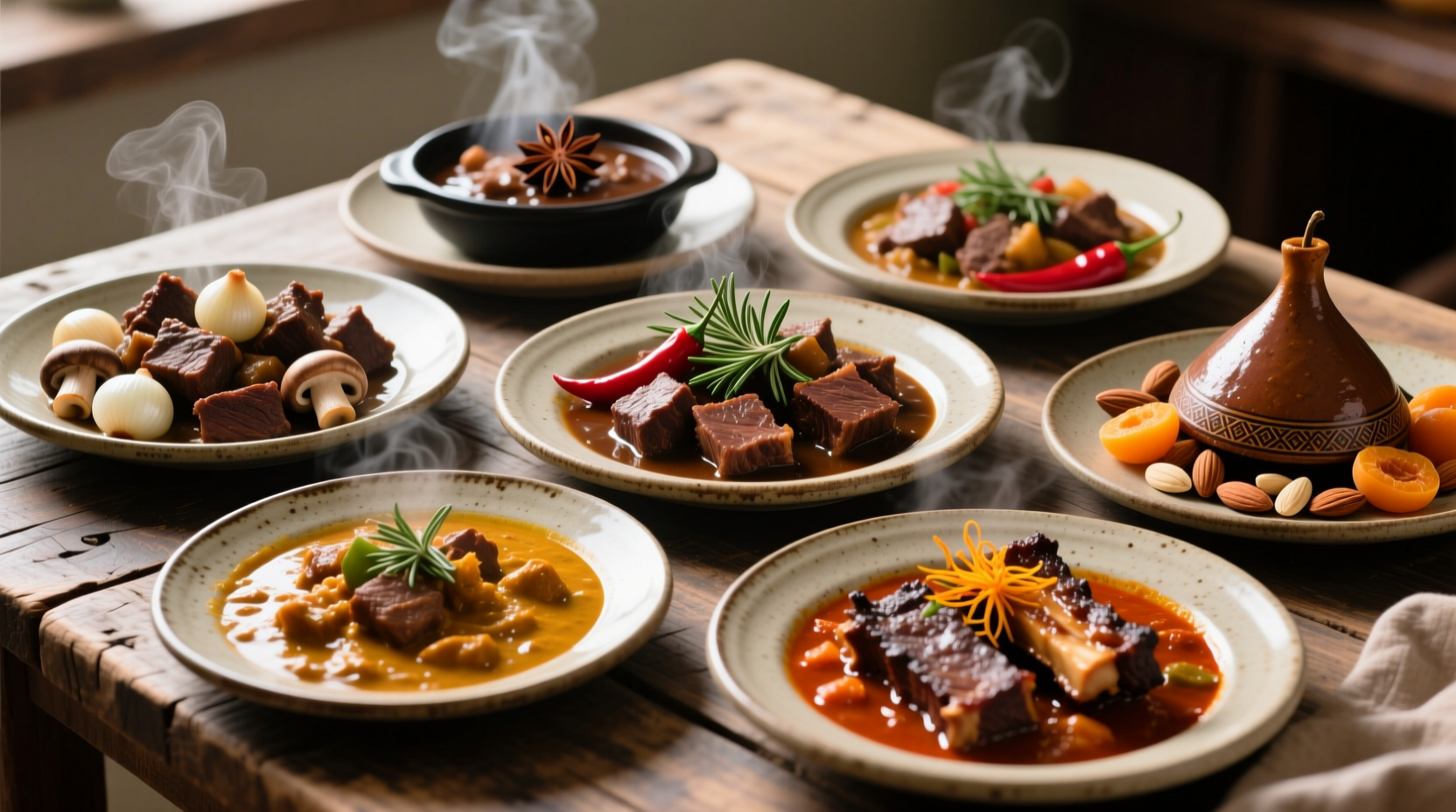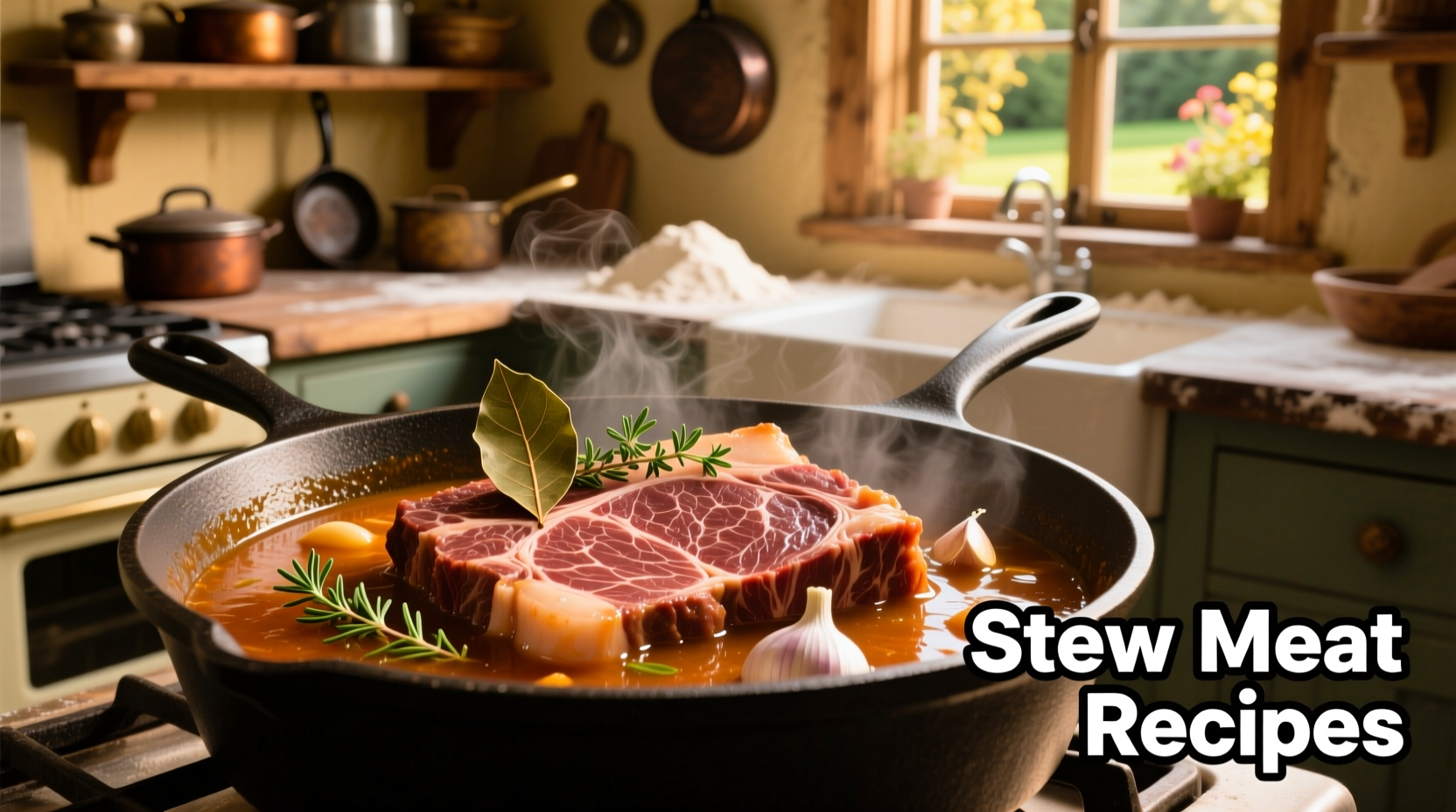If you're wondering what you can cook with stew meat beyond traditional stews, you have numerous delicious options. Stew meat works perfectly for slow-cooked dishes like beef bourguignon, Korean galbi jjim, Mexican birria, and Caribbean oxtail stew. You can also transform it into hearty chili, pot roast, or even stir-fry if cut thinly against the grain. The key is understanding that stew meat comes from tougher cuts requiring slow, moist cooking methods to achieve tenderness, but with proper preparation, it becomes incredibly flavorful and versatile.
Stew meat often sits forgotten in the back of your freezer or refrigerator, waiting for that one traditional stew recipe you might not feel like making. What if you could transform those tough cuts into seven completely different global dishes that satisfy diverse cravings while maximizing flavor and tenderness? Understanding how to work with this affordable cut opens up a world of culinary possibilities beyond the standard pot of stew.
Why Stew Meat Deserves More Than Just Stew
Stew meat typically comes from tougher cuts like chuck, round, or brisket—muscle groups that get significant exercise in the animal. According to the USDA Food Safety and Inspection Service, these cuts contain more connective tissue that requires slow cooking at low temperatures to break down collagen into gelatin, creating that melt-in-your-mouth texture we love. This scientific principle means stew meat isn't limited to stews—it shines in any slow-cooked preparation.
| Cut Type | Best Cooking Method | Approximate Cooking Time | Flavor Profile |
|---|---|---|---|
| Chuck | Braising, slow cooking | 2-3 hours | Rich, beefy, marbled fat |
| Round | Slow roasting, pressure cooking | 1.5-2.5 hours | Leaner, mild beef flavor |
| Brisket | Smoking, braising | 3-5 hours | Intensely beefy, substantial fat |
7 Creative Ways to Cook Stew Meat Beyond Traditional Stew
1. Korean Galbi Jjim (Braised Short Ribs)
This elegant Korean dish transforms stew meat into a sweet-savory masterpiece. While traditionally made with short ribs, chuck roast works perfectly as a more affordable alternative. The key is simmering the meat in a pear-ginger marinade that tenderizes while infusing complex flavors. According to research from the Korean Food Research Institute, the natural enzymes in Korean pears help break down tough fibers while adding subtle sweetness without refined sugar.
2. Mexican Birria
Originating from Jalisco, Mexico, birria has gained international popularity for good reason. This rich, spicy stew traditionally uses goat but adapts beautifully to beef stew meat. The secret lies in the dried chile paste—guajillo, ancho, and pasilla chiles toasted and rehydrated create a complex base that tenderizes the meat while adding depth. For authentic results, follow the traditional technique of slow-cooking until the meat pulls apart easily with a fork.
3. Caribbean Oxtail Stew (With a Stew Meat Swap)
While authentic Caribbean oxtail stew uses, well, oxtail, you can achieve similar results with beef shank or chuck stew meat. The key is the Scotch bonnet pepper and allspice combination that defines Caribbean flavor profiles. University of the West Indies culinary research shows that the slow simmering process allows the connective tissues in tougher cuts to break down completely, creating that signature gelatinous texture that makes these dishes so satisfying.
4. Pressure Cooker Beef Ragu
Save hours of simmering with this modern twist on traditional Italian ragu. Using a pressure cooker reduces cooking time from 4-6 hours to just 45 minutes while still achieving that fall-apart tenderness. The high pressure forces liquid deep into the meat fibers, accelerating the tenderizing process. For best results, sear the meat first to develop flavor through the Maillard reaction before pressure cooking with tomatoes, wine, and aromatic vegetables.
5. Beef and Vegetable Pot Pie
Elevate your stew meat into a comforting pot pie by incorporating it into a rich gravy with root vegetables. The enclosed baking environment creates steam that further tenderizes the meat while the pastry top adds textural contrast. Food science research from the Culinary Institute of America shows that the combination of moist heat from the filling and dry heat from the oven creates the perfect environment for transforming tough cuts into tender morsels.
6. Beef Chili with a Secret Ingredient
Take your chili from ordinary to extraordinary by using stew meat instead of ground beef. The slow cooking process allows the meat to develop deeper flavor as it breaks down. For added tenderness, try the chef's trick of adding a small amount of baking soda (about 1/4 teaspoon per pound) to the cooking liquid—it raises the pH slightly, helping break down proteins more efficiently without affecting flavor.
7. Asian Beef Stir-Fry (With Proper Preparation)
Yes, you can use stew meat for stir-fry! The secret is in the preparation. Slice the meat paper-thin against the grain, then marinate in a mixture of cornstarch, soy sauce, and rice wine for at least 30 minutes. The cornstarch creates a protective layer that prevents overcooking during the quick stir-fry process. This technique, documented in Grace Young's The Breath of a Wok, transforms even tough cuts into tender stir-fry components.

Essential Techniques for Perfect Stew Meat Every Time
Dry Brining for Maximum Flavor
Season your stew meat with salt 12-24 hours before cooking. This allows the salt to penetrate deep into the meat, enhancing flavor throughout rather than just on the surface. Food science research from America's Test Kitchen shows this technique improves moisture retention by up to 20% during long cooking processes.
The Sear Matters More Than You Think
Take time to properly sear your meat in batches. Crowding the pan lowers the temperature and causes steaming instead of browning. That beautiful brown crust? It's packed with flavor compounds created through the Maillard reaction that will infuse your entire dish. Don't skip this step—even if you're using a slow cooker.
Liquid Ratio Secrets
Many home cooks use too much liquid when braising. Your stew meat should be partially submerged, not swimming. The ideal ratio is about 1 part liquid to 2 parts meat by volume. As Harold McGee explains in On Food and Cooking, this concentration allows flavors to develop more intensely while still providing enough moisture for tenderizing.
Budget-Friendly Tips for Stew Meat Success
- Buy in bulk: Purchase larger cuts and cut them yourself—saves up to 30% compared to pre-cut stew meat
- Freeze in portions: Divide into recipe-sized portions before freezing to avoid thawing more than needed
- Use cheaper aromatics: Onions, carrots, and celery provide flavor foundation at minimal cost
- Stretch with beans: Add inexpensive beans or lentils to extend servings without compromising nutrition
Food Safety Guidelines for Stew Meat
According to the USDA Food Safety and Inspection Service, cooked beef should reach an internal temperature of 145°F (63°C) with a three-minute rest time. However, for tough cuts like stew meat that require long cooking, you'll want to continue cooking until the meat reaches 190-205°F (88-96°C), where collagen fully converts to gelatin. Always refrigerate leftovers within two hours, and consume within 3-4 days for optimal safety.
Make-Ahead and Storage Tips
Stew meat dishes often taste better the next day as flavors continue to meld. For best results, cool completely before storing in airtight containers. Properly stored, cooked stew meat dishes will keep for 3-4 days in the refrigerator or up to 3 months in the freezer. When reheating, do so gently over low heat to prevent the meat from becoming tough again.
Can I use stew meat in place of ground beef?
Yes, but with preparation. Cut stew meat into small pieces and cook slowly until completely tender before using in recipes that call for ground beef. The texture will differ slightly but the flavor will be richer. For dishes like chili or sloppy joes, this substitution works particularly well.
How do I prevent stew meat from becoming dry?
Stew meat becomes dry when cooked too quickly at high temperatures. Always use low, slow cooking methods with enough liquid to maintain moisture. The meat should be partially submerged, not floating. Check periodically to ensure liquid hasn't evaporated completely, adding more as needed during the cooking process.
What's the minimum cooking time for stew meat to become tender?
Most stew meat requires at least 1.5-2 hours of simmering at low heat to become tender. Chuck and brisket may need 2.5-3 hours. The meat is done when it easily pulls apart with a fork. Rushing the process results in tough, chewy meat regardless of cooking method.
Can I use a slow cooker for all these stew meat recipes?
Absolutely. Slow cookers work exceptionally well for stew meat dishes. For best results, sear the meat first, then transfer to the slow cooker with other ingredients. Cook on low for 6-8 hours or high for 3-4 hours. The consistent low temperature creates ideal conditions for tenderizing tough cuts while developing deep flavors.











 浙公网安备
33010002000092号
浙公网安备
33010002000092号 浙B2-20120091-4
浙B2-20120091-4